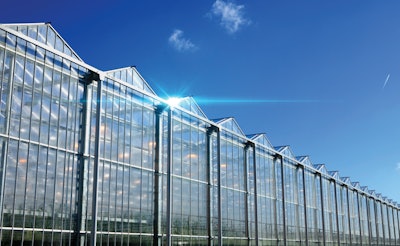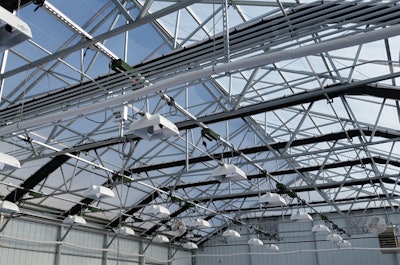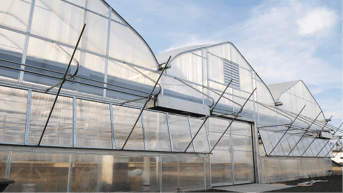
As more large-scale greenhouse operations enter the rapidly maturing cannabis industry, it is increasingly important to properly assess the benefits greenhouses may offer your business. Cannabis Business Times reached out to experts in the cannabis and greenhouse industries for these tips – with more to follow in Part II of this special feature in the next issue – on navigating greenhouse options, optimizing structures and preparing for what’s ahead:

Dave Bishop
Sales Director
Conley’s Greenhouse
Manufacturing
Montclair, Calif.
1. Choose the right structure for your location.
“Location is everything. ... In many urban areas, you may be required to have engineered stamped plans in order to build the greenhouse. You can’t just purchase any over-the-counter or catalog greenhouse and expect it to pass the requirements.
“In rural areas, you may not be required to have engineered stamped plans, but you still want your greenhouse to withstand [regional] wind and snow loads. Most greenhouse companies are familiar with what will work in your area. Make sure your provider warranties the house they sell you for snow and wind.”
2. Realize how location affects cooling.
“Many people do not take the conditions of their location into account. For example, in certain areas of Colorado, evaporative cooling is not needed because it rarely heats up to 90 degrees. However, in most of the rest of the state, evaporative cooling is absolutely critical for optimum production because of extreme heat or the solar heat gain in high elevation.
“In areas where temperatures do not reach high degrees, natural ventilation is sufficient. Simply having roll-up curtains to allow air in and ridge vents at the greenhouse peak to allow heat to escape is sufficient. ... In many coastal areas, the humidity level is too high for evaporative cooling to work effectively. A system of cooling air without creating more humidity works in these environments.”
3. Don’t skimp on control systems.
“It’s important to have the correct control system for your greenhouse and well worth the additional money to have all fans, heaters, cooling, lights, etc., working on one controller. Many times, no one will be in the greenhouse. You want to be sure that everything will function properly when no one is there. Additionally, it is well worth the money to have an alarm function on your controller that will alert you on your mobile phone or land line if there is a problem. This crop is one of the most expensive crops grown. It is not worth saving a few dollars to jeopardize [it].”

J. Paul Brentlinger
President and
Co-Owner
CropKing, Inc.
Lodi, Ohio
4. Focus on engineered structures.
“Too many companies are looking to profit off the boom in the industry by selling bent steel without having it engineered for proper wind and snow loads given the area. This has become a game even among some more respected greenhouse companies that apply snow and wind loads based on a heated greenhouse. Non-engineered structures are typically going to be less expensive than a company that employs engineers to design and examine their structures and ensure they stand up to X miles per hour of winds and a certain amount of snow load. A stronger greenhouse means more steel, and that means more money.”
5. Understand the terminology.
“Given the age of this legal industry ... many people confuse the term ‘greenhouse’ and think it includes anything made out of bent steel and plastic cover. When we discuss greenhouses, we’re referring to CEA, or Controlled Environment Agriculture, which indicates we are using additional equipment to apply as much control as possible on the growing environment. These computer controllers can range in price from a few thousand dollars to hundreds of thousands.”
6. Move toward higher-end CEA.
“The reason we go into a greenhouse is because it gives us a level of control. The greater control you have, the more you control variable costs over the years you’re in business. You’ll pay [over time] for buying a cheaper greenhouse because you won’t be able to control your environment. ... Make sure you have the proper equipment, which would include a high-quality environmental controller that can control heat, cooling, humidity, fertigation, lighting and light deprivation. Integrate it, so you can have a dashboard of what’s going on in your environment.”

Paul Golden
CEA engineer
Nexus Greenhouse Systems
Northglenn, Colo.
7. Passive or mechanically operated?
“One of the first questions to ask yourself when choosing a structure is: Do I want a passively designed greenhouse or a mechanically operated greenhouse? … It is essential to take into consideration the variability of weather in the region.
“For example, a passive greenhouse with roof (or side) vents might be appropriate if the grower is building a greenhouse in a dry Mediterranean climate. [But if a region’s outdoor temperature] exceeds the desired greenhouse temperatures, then a passive house is not ideal, and the grower should consider a greenhouse with mechanical cooling. With mechanical cooling, a grower can achieve indoor temperatures below outdoor temperatures when desired. You [can] combine passive cooling and mechanical cooling, but most commonly one system is chosen.”

8. Control humidity.
“Many people improperly believe that roof vents are necessary to eliminate unwanted humidity in the greenhouses. Although roof vents do aid in managing humidity during the day, they are often of little value for dehumidifying when the light deprivation system is closed at night. Light deprivation curtains do not allow moisture to leave the area below the curtain (where the plants are) when they are closed in a passively cooled design.
“It is most important to maintain proper humidity levels during blackout hours to prevent mold. ... Most growers choose to use mechanical ventilation to provide dehumidification to the greenhouses both in the day and night. ... Mechanical venting should be used in combination with heating the replacement air to further reduce the humidity levels.”
9. Control odor.
“If cannabis odors are of concern, then a mechanically cooled greenhouse system prevails over a passively cooled greenhouse system. In particular, a negative-pressure system performs the best. Both positive-pressure and passively vented greenhouses have air (and odors) escaping from multiple locations throughout the structure. Negative pressure greenhouses have all of the exhaust air coming out from a point source (the exhaust fans). It is very easy to odor mitigate the smells of a cannabis cultivation facility if the source of those smells is an exhaust fan. It is very challenging to odor mitigate if the source of the smells is from a set of vents.”
10. Understand the pros and cons of passive versus mechanical ventilation.
“It is important to understand the benefits and downfalls of passive versus mechanically vented greenhouses to avoid the pitfalls with each. Mechanically cooled greenhouses do use slightly more energy than a passive greenhouse, but far less energy than a warehouse. Many passive greenhouse systems were not designed with cannabis in mind. Mechanically vented greenhouses offer a greater degree of control and are easier to odor mitigate.”


Chris Dayboll and Leigh Coulter
Sales Representative, Cannabis Division/President GGS Structures, Inc. Vineland Station, Ontario
11. Understand license parameters.
“Determining the total square footage is normally based on the [state cultivation] license, which either allows you to grow a certain number of plants or gives you a square footage allowance. If you are in a state with license by plant count, then you need to think about how you are going to space your plants. If you have a square-footage allowance, remember that is the square footage of the canopy, so a 30,000-square-foot license will generally build around a 40,000-square-foot greenhouse, factoring in aisle space and other working areas.”
12. Optimize harvesting; eliminate inefficiencies.
“You want to determine the veg/flower balance to optimize harvesting, and [whether] you will be moving plants from veg room to flower room or ... are going to eliminate the operating inefficiencies of transporting plants by investing in rooms that will convert from veg to flower and back to veg as your cycle demands. Note that if your license is by square footage, you will likely want to go with moving plants since you can significantly increase plant density in veg rooms. Generally 20 to 30 percent of the space is in vegetation. In a greenhouse, rooms are called zones, and they are easily achieved by constructing inside walls between the post lines.”
13. Get the total picture.
“Look at the design layout of the greenhouse, which is the style of greenhouse, overall length, width, and the size and shape of the zones inside. For this, it is important to work with a greenhouse manufacturer that has lots of experience with cannabis. ...
“[Avoid] falling victim to the cookie cutter ‘this is a cannabis greenhouse’ mentality. There is no one-solution-fits-all in greenhouse cultivation. There are certain elements in every greenhouse growing cannabis, however. The size, layout, style of greenhouse, choice of heating and cooling systems, and structural load-bearing considerations are all factors of where you are growing and how you are growing.”
14. Let features simplify growing.
“Within the greenhouse structure design, there are a few features that can make it easier for growers:
- Square and rectangular post material is easier for construction than round shapes, which require clamps for connections. Sidewalls and inside walls connect easier to the flat surface of a square post.
- Hot dipped galvanized steel is the industry leader for corrosion protection.
- Because light deprivation is so important for getting the most out of your cannabis crop, it is an advantage to have a flat energy truss below the gutter for the light deprivation curtain to attach straight across. Curtains can be installed on an angle, but if the greenhouse is designed with a flat surface for the curtains, it is better. The truss below the gutters also leaves the attic area in the peak open, which helps with ventilation, and increases the amount of light that gets to the crop.
- Pick roof and sidewall glazing materials that maximize the natural light within considerations of budget and any code requirements.”

Nic Easley
Chief Executive Officer
3C Comprehensive Cannabis
Consulting
Denver, Colo.
15. Embrace the lessons of agriculture.
“When looking into greenhouse cultivation, many growers came from small cannabis [with] illicit market experience, which they scaled and ramped up into legal production in warehouses. They’ve never done good agricultural practices (GAPs) or good manufacturing practices (GMPs), or even best management practices (BMPs) for greenhouse cultivation. I’d … look to outside agricultural experts and industries, other than just thinking we’re going to grow in a greenhouse just like we grew in a warehouse, and it’s going to be the same. That’s absolutely not the case – for how you cultivate plants in vegetative state, how you train plants for maximum canopy control, or how much soil, water and nutrients are required for adequate production and growth.
“... If you embrace the lessons of agriculture … versus just the cannabis industry, it will make your cannabis operation that much stronger, more productive, compliant and profitable. Focus on looking for time-tested ag wisdom, and [merge it with] the best of cannabis knowledge … to make cannabis agriculture your new focus.”

16. Know your location and match it.
“When it comes to agriculture, location is everything. Let’s say you’re trying to put a greenhouse in the bottom of a valley that doesn’t have a very good sun window, for example. In the northern hemisphere, we need to have a great south-facing exposure. If you don’t have that and you put it down in the shaded valley, you’re going to be losing an hour of your direct sun in the morning and an hour of direct sun in the evening. So you want to make sure you have that great active solar window.
“Match your greenhouse design to the climate that you’re building in, instead of trying to take your plan and your idea, and force it on a location. It’s just not going to work unless you build that building specifically for that agricultural zone, knowing the frost-free days, and knowing that with light deprivation and light augmentation, how much light needs to be augmented in the morning or in the evening in the winter time, as well as how much needs to be limited at summer solstice in the morning or the evenings.”
17. Don’t overlook the potential of a greenhouse.
“When I say the term hybrid, four-season greenhouse, I mean that’s a greenhouse that does light augmentation in the winter. Then in the summer, there are automated curtains that close and limit the light when the days are really long. Also, there are systems that control ventilation, light intensity, heated floors and CO2 enrichment. These are done from computer programs and sensors that monitor and control these items for you.
“I’ve seen greenhouses built where they’re just hoping to do their summer crops and just do light deprivation because they don’t want to have the additional cost of light augmentation. But light augmentation would give them an extra two-plus harvests over just doing light deprivation alone. So they’re not looking to fully capitalize on these four-season models. They’re concerned about the cost of heating and additional technology, and think that it’s going to cost more, but that’s just a common misconception.
“The right technology – not just more technology, but appropriate technology – goes a long way in cannabis. They’re overlooking the true potential of a greenhouse by just looking at it as a summer hoop house or a summer flowering greenhouse versus a hybrid, four-season greenhouse.”
18. Don’t be left behind.
“If you’re looking to stay profitable, if you’re looking to stay relevant, if you’re looking to produce the highest-quality [product] for patients or for adult-use consumers, greenhouse and eventually outdoors will be the way this is done. Indoors is just temporary while the industry establishes because the industry came from an out-of-sight, out-of-mind mentality. The only reason we know how to do indoors is because we went inside to hide, and to most growers, that is all they knew. ...
“The average cost nationwide to produce a pound of indoor finished product, all in – that’s marketing, branding, security, compliance, nutrients, every cost included – is about $983 for an indoor pound. Greenhouse is anywhere from a little below $100 to $215, depending on methodology and location. Prices are going down because there are more and more large-scale producers that are producing and flooding the market with an abundant high-quality supply. If [growers are] not looking to greenhouse and thinking about scaling up [their] operation and redesigning, it’s just a matter of time until people get put out of business unless they embrace agriculture and refine their methodology.”

Tom Vezdos
Vice President
Commercial Division
Rough Brothers, Inc.
Cincinnati, Ohio
19. Don’t try to apply indoor concepts.
“Many growers try to take what they know and how they grow indoors and apply the same concepts to a greenhouse. For example, they try to create small rooms or segmented zones in the greenhouse because they’re used to growing in a building that has rooms. They don’t realize it adds a lot of cost to your greenhouse design by breaking it up and forcing those zones to occur when it’s not really needed. When they go to a greenhouse, they need to think large-scale, wide-open – which makes it much more cost effective.”
20. Understand solar energy variables.
“Indoor growers sometimes struggle with understanding the amount of solar energy that’s given by the sun and how that affects plants. They’re used to very steady-as-she-goes light. They turn the lights on; it’s constant at 8 a.m., and it’s constant at 5 p.m., all the way through the day.
“[With a greenhouse], at peak times, they need to make sure to provide enough nutrients and water to accommodate that higher spike in solar radiation or higher photosynthesis. They have to account for both seasonality and the times of the day.”
21. Know your system limitations.
“Growers need to understand good, better, best systems in greenhouses and how they affect crop quality. If they try to take a design out of the Southwest and put it into the Southeast or the Northeast or the Northwest, it doesn’t work the same. Remember, a greenhouse uses the external environment to help manage the internal environment. If you don’t know your external environment and what its effects are going to be, it’s going to create some chaos inside — if you’re trying to lower humidity in a greenhouse, for example, but the humidity outside is just as high as inside.
“There are different systems and different levels of systems that can handle all these issues. They become more costly the more control you want to have 24 hours a day, 7 days a week, 52 weeks out of the year.
“Often the greenhouse structure is only 25 percent of the total cost of a cannabis facility. The environmental systems will be the majority of your costs, not the structure.”















